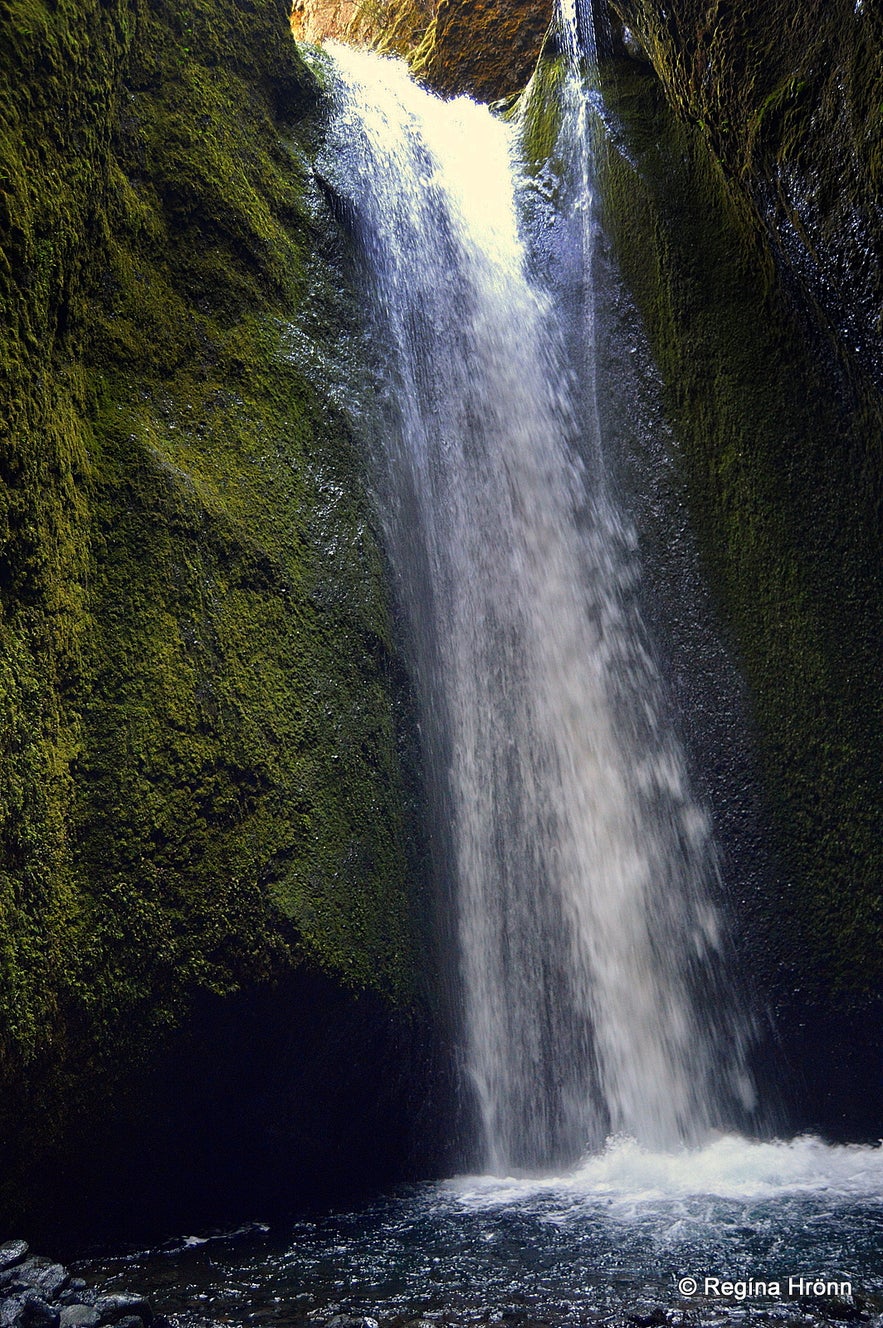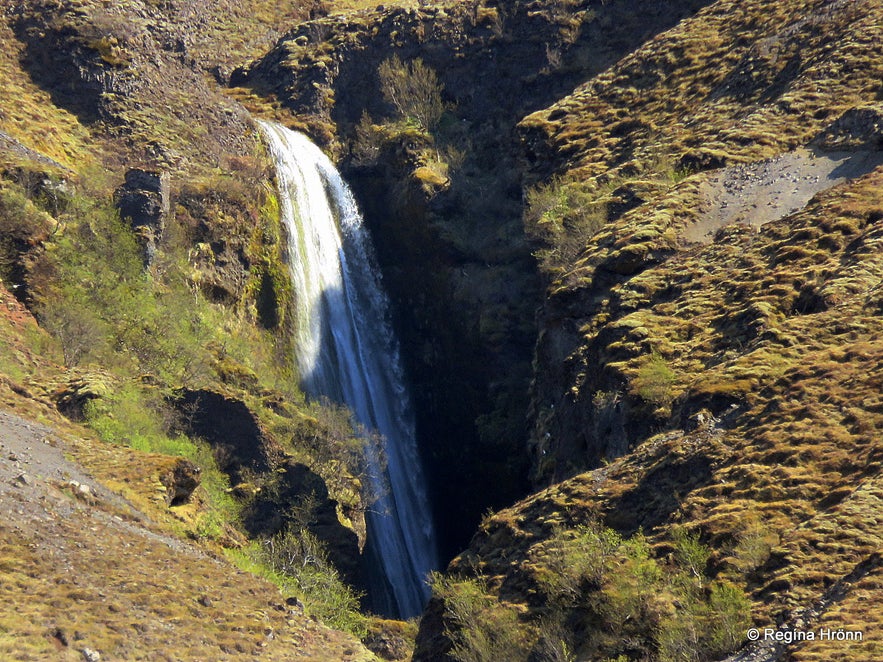
The Mystical Nauthúsagil Ravine in South Iceland & its beautiful Waterfalls

There are some hidden places in Iceland, which are like out of this world. I visited one of them recently, the mystical Nauthúsagil ravine in South Iceland, which translated to English means Bull Shed Ravine.
I know that the name sounds a bit strange, but I will explain how this name came about a little further on in my travel-blog.
Top photo: a hidden waterfall in Nauthúsagil ravine

The beginning of the hike into Nauthúsagil
Characteristic of Nauthúsagil is the rowan that grows on the rims of the ravine and in some places it creates a see-through roof, which almost covers the ravine from above and adds to the mystique.
It is especially beautiful when the sun shines through the rowan and into the ravine.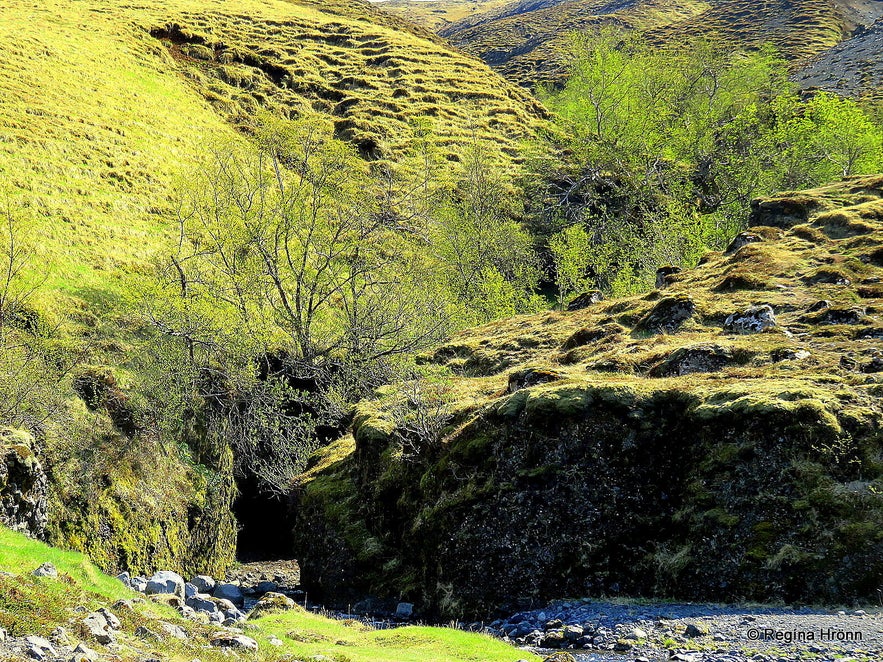
Rowen in Nauthúsagil
I visited the Nauthúsagil ravine for the first time in May when the vegetation was still a bit wilted and yellow, but the rowan was green and lush.
There is a waterfall in Nauthúsagil ravine, several of them, I think.
To reach the first waterfall at the end of the ravine one has to wade the small river or jump on stepping stones, but at one point there are chains available to help with climbing over a small waterfall on the way.
It is relatively easy.
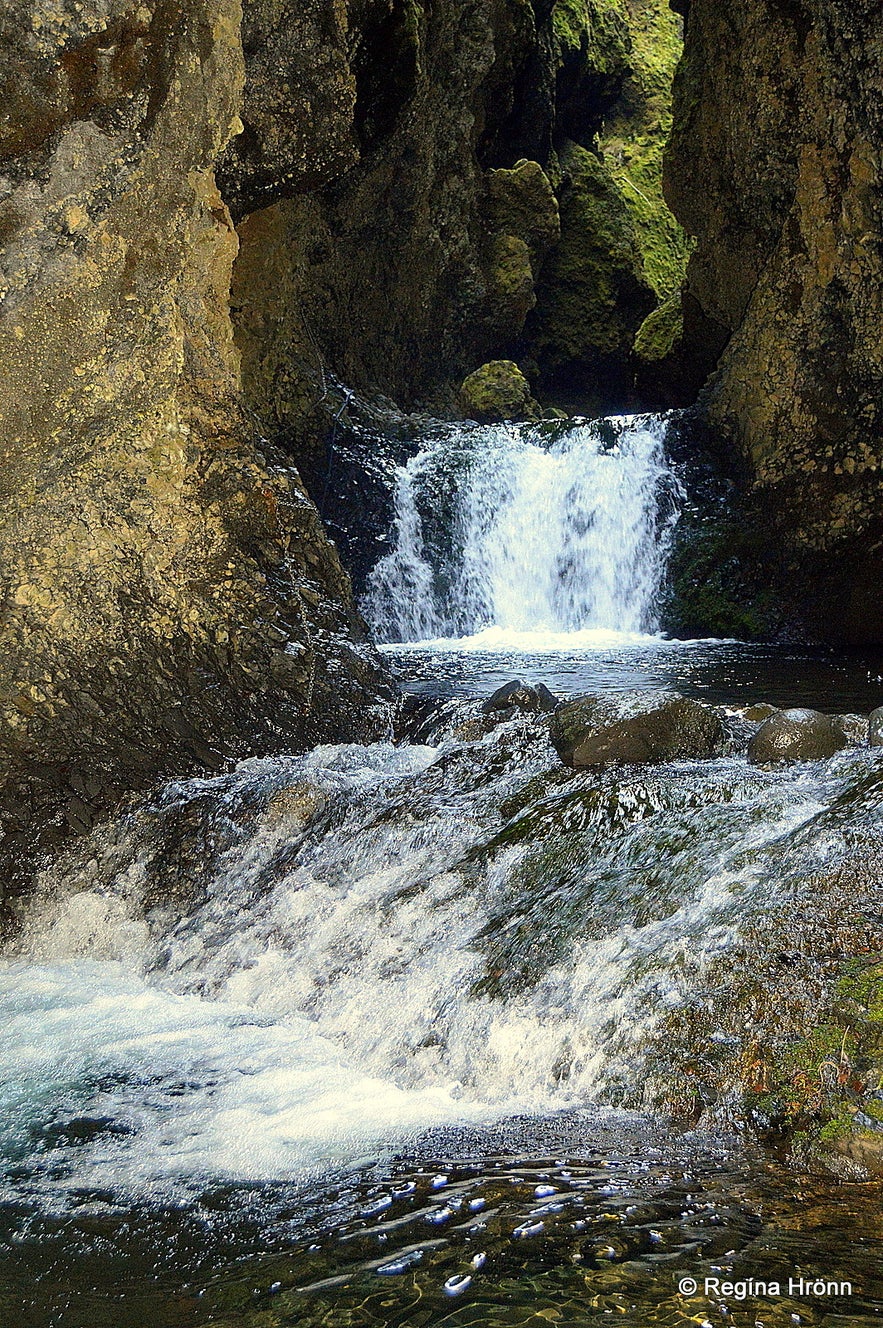
Nauthúsagil
Nauthúsagil is located behind Stóra-Mörk farm, where my husband has got relatives, and the name is believed to stem from an actual bull shed being built here for the bulls from Stóra-Mörk farm.
The bulls grazed in this area with other non-milking stock.
A smallholding, Nauthús, stood here but was abandoned in 1777 due to the excessive haunting of the farm - and it is believed that this area is still haunted!
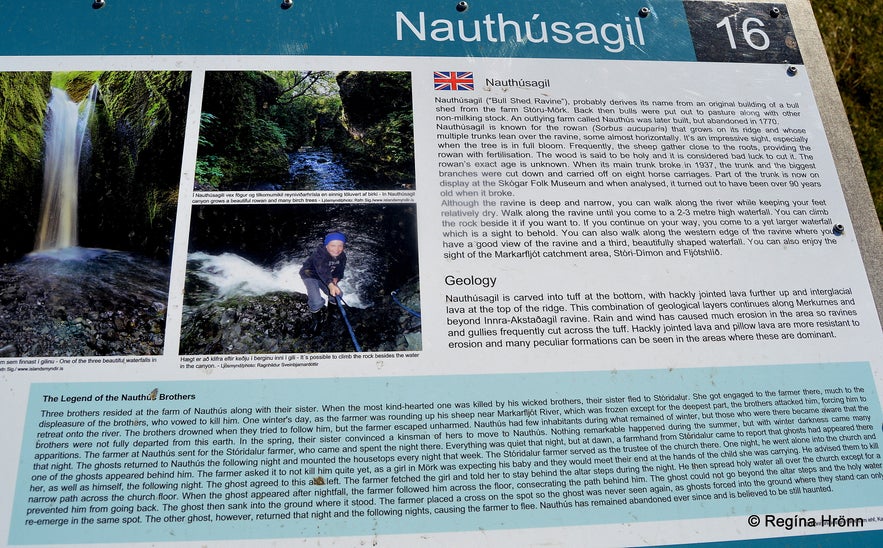
You will find information signs about Nauthúsagil by Katla Geopark just before you enter the ravine.
Katla UNESCO Global Geopark has put up very useful information signs at interesting locations in the Geopark, and Nauthúsagil is number 16.
Now, let's hike up the small river, Nauthúsaá, and explore this small and narrow ravine.
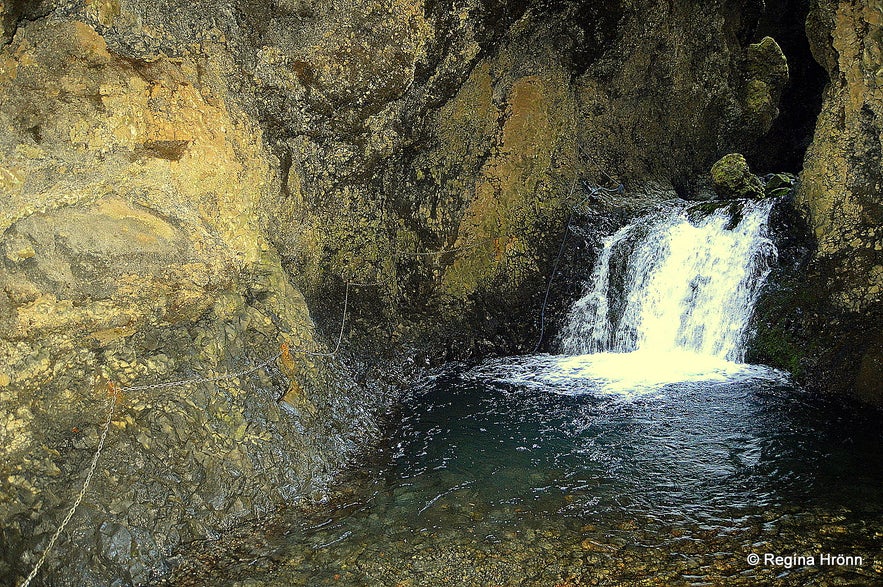
Nauthúsagil
Wear boots as you will have to step on stones in the small shallow river in the ravine and in one spot you will find chains to help with getting up and down a small waterfall (very small).
But even though it is small it is difficult ascending without the chains.

Very useful chains and ropes in Nauthúsagil
This is when boots come in very handy as you will also be able to wade the river and don't have to step on the slippery stepping stones.
I have also heard that sandals are good for wading in the river, but I prefer boots.
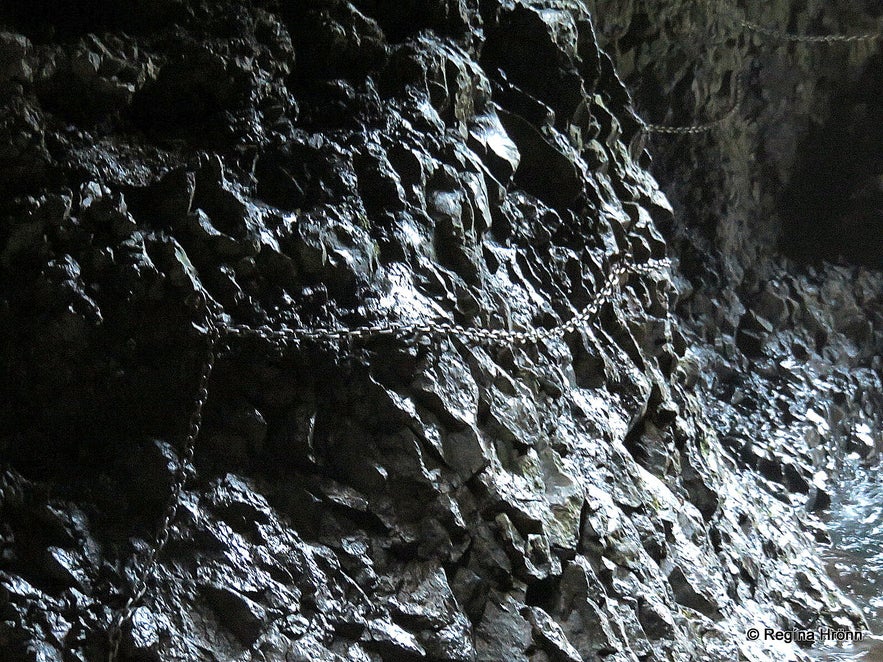
Nauthúsagil - chains help when stepping on the wet rocks
It took me some 20 minutes to reach the waterfall with lots of photo-stops on the way.
It is a short hike, so if you are not taking a lot of photos I would say that it takes some 35-40 minutes to visit this ravine.
It is amazing hiking in the ravine with the trees covering the sky above, quite magical.
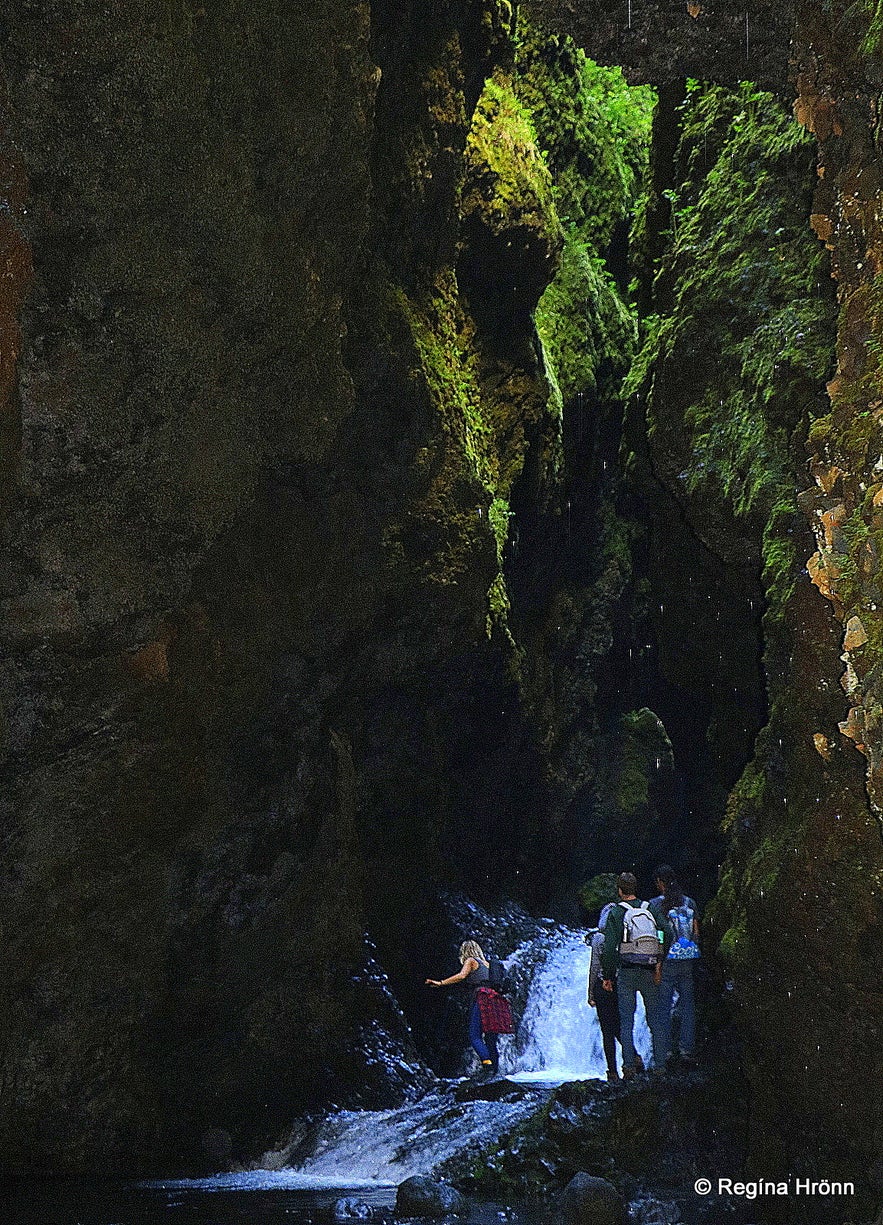
Hiking in Nauthúsagil
At the end of the ravine, you will be rewarded with a very lovely waterfall and feel like you are alone in nature or that you stepped into a fairy-tale film.
I can tell you that I just wanted to stay there, I was completely in awe.
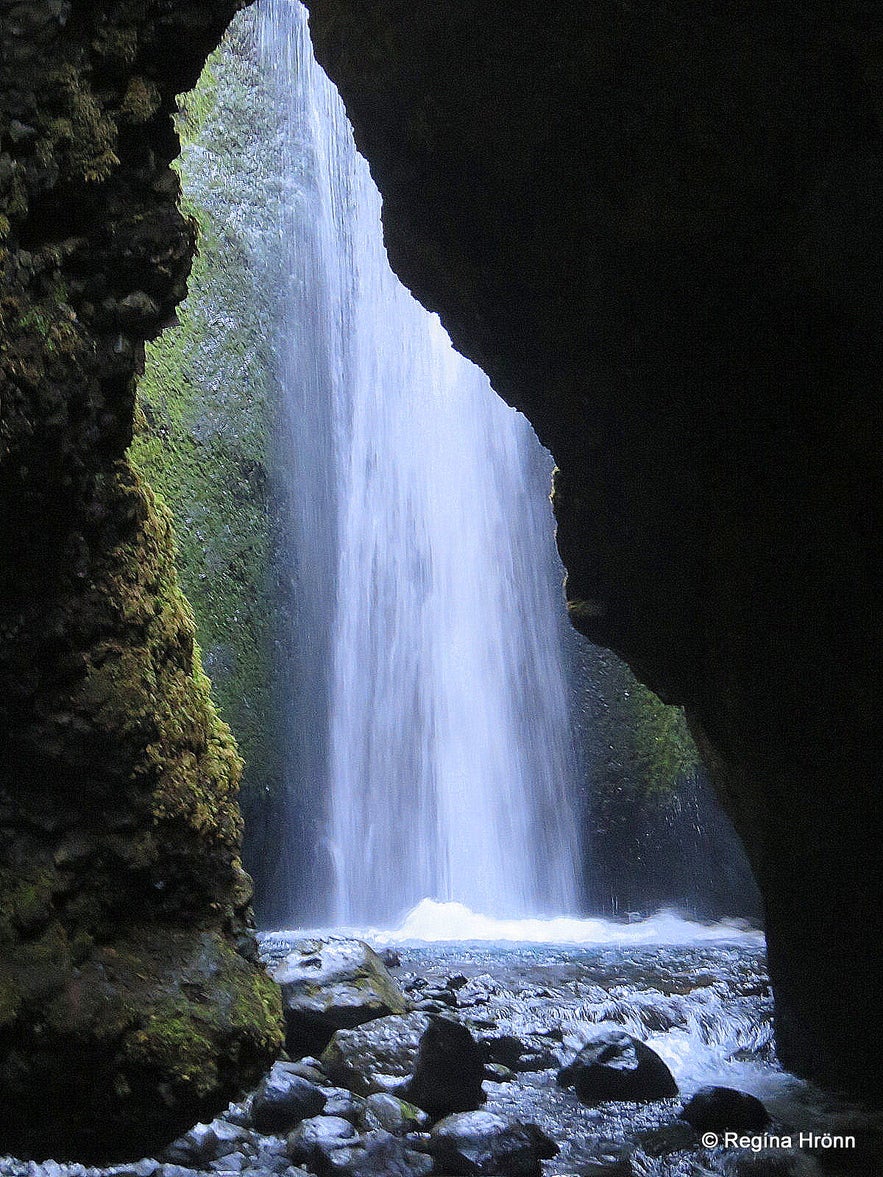
The waterfall in Nauthúsagil
Nature provides us with so much beauty and I love to find hidden away waterfalls like this one.
I felt so peaceful and enthralled, it almost felt like the hidden people of Iceland - the elves would appear by the waterfall at any moment :)
I have read that you can climb up the walls by this waterfall, but if that can be done, then it is not for me. But there are other waterfalls above, which I would love to visit.

Very happy in Nauthúsagil :)
There was mist by the waterfall and I got drenched when my husband took my photos in front of it.
He took his time while I was standing there getting drenched ;)
Guard your lens while taking photos, it is only possible to take 2-3 photos before the lens gets too wet.
The waterfall in Nauthúsagil
We stayed by the waterfall for some time before heading back.
It was easier descending the small waterfall than it was ascending it. I didn't use the chains but slid down it seeing that I was already soaking wet.
My husband took his shoes off while descending and carried them on his shoulder (photo below).
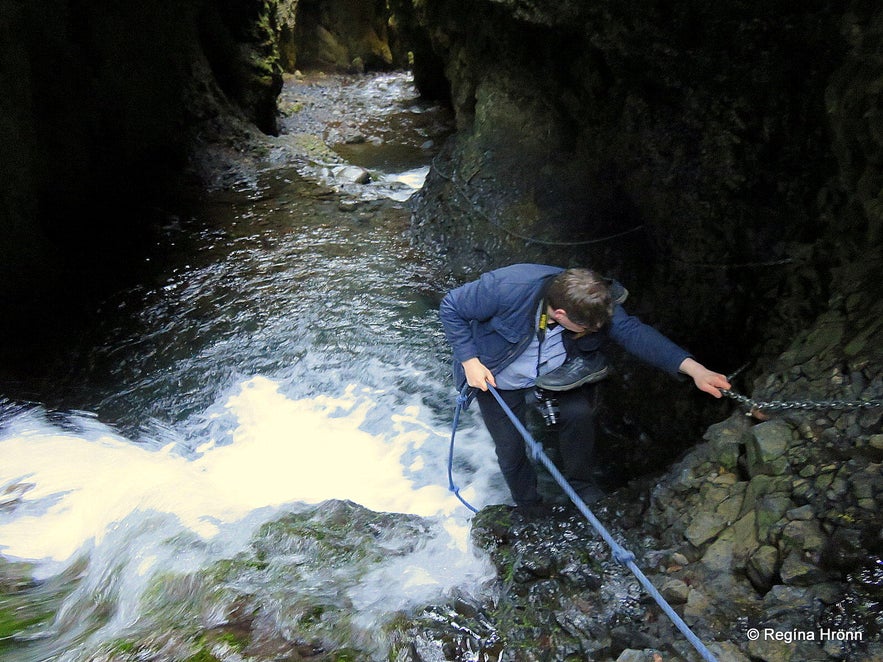
The chains and rope come in handy when hiking in Nauthúsagil
Now let's go back to the rowans which are so characteristic of the Nauthúsagil ravine.
The main trunk of the rowan tree was said to be the largest in Iceland and when it was measured in 1930 its trunk was said to be 1.5 in diameter and around 9 meters high!
It broke in 1937 and part of the trunk is on display at Skógasafn Museum. The tree was analyzed and turned out to be no less than 90 years old! There aren't many trees in the nature of Iceland, so this is amazing for Iceland.
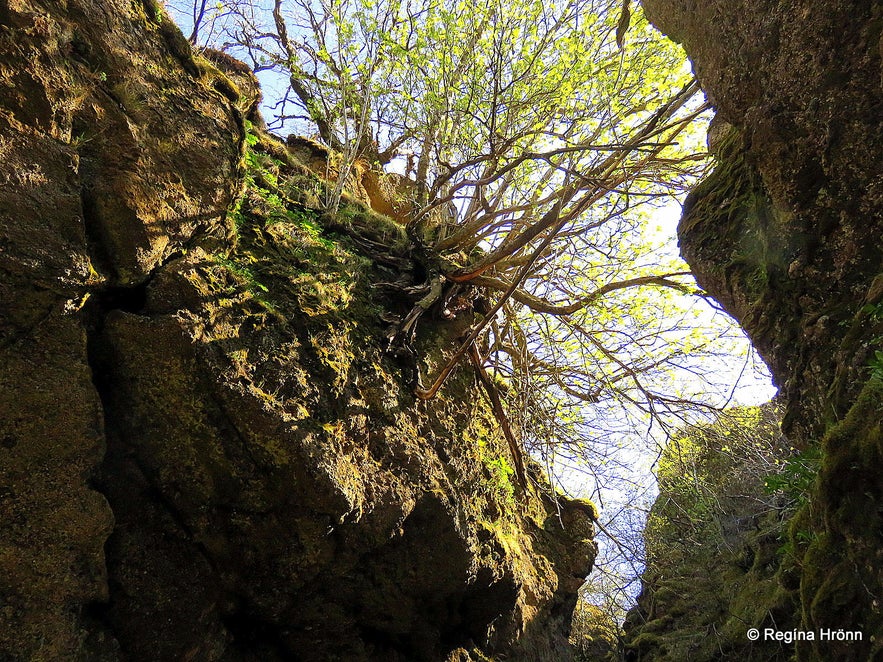
Rowans in Nauthúsagil
The old rowan was said to be holy and bad luck would follow those who would cut it down.
One of the explanations for the rowan growing to such a big size is that sheep had made a shelter by its roots so the rowan got a lot of nourishment.
In 1900 the farmer at Múlakot in Fljótshlíð north of Nauthúsagil took some rowan from the ravine and gave to his sister.
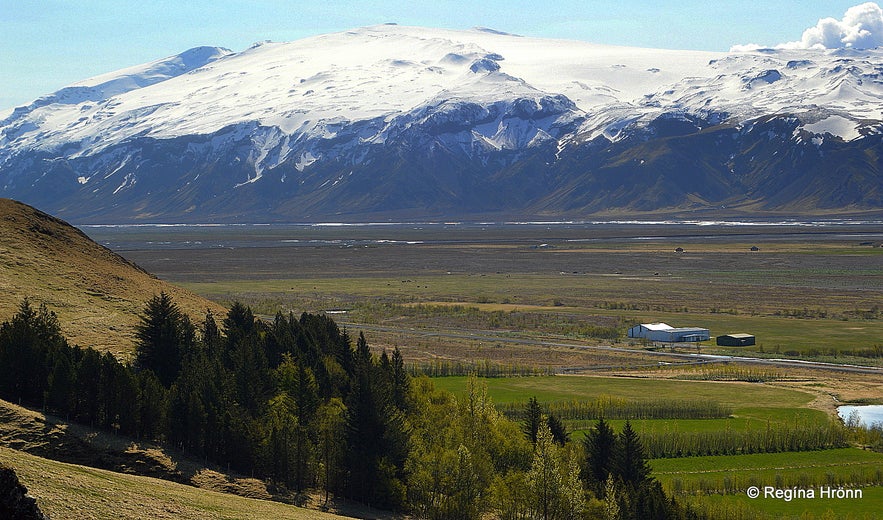
The view from Fljótshlíð of Eyjafjallajökull glacier
She cultivated a private ornamental garden, which became famous in Iceland for its beauty.
You can maybe see parts of it in my photo above, which I took when I was visiting the beautiful Gluggafoss waterfall. In the distance, you will see the notorious volcano Eyjafjallajökull.
And somewhere below the volcano, the Nauthúsagil ravine is hidden away.
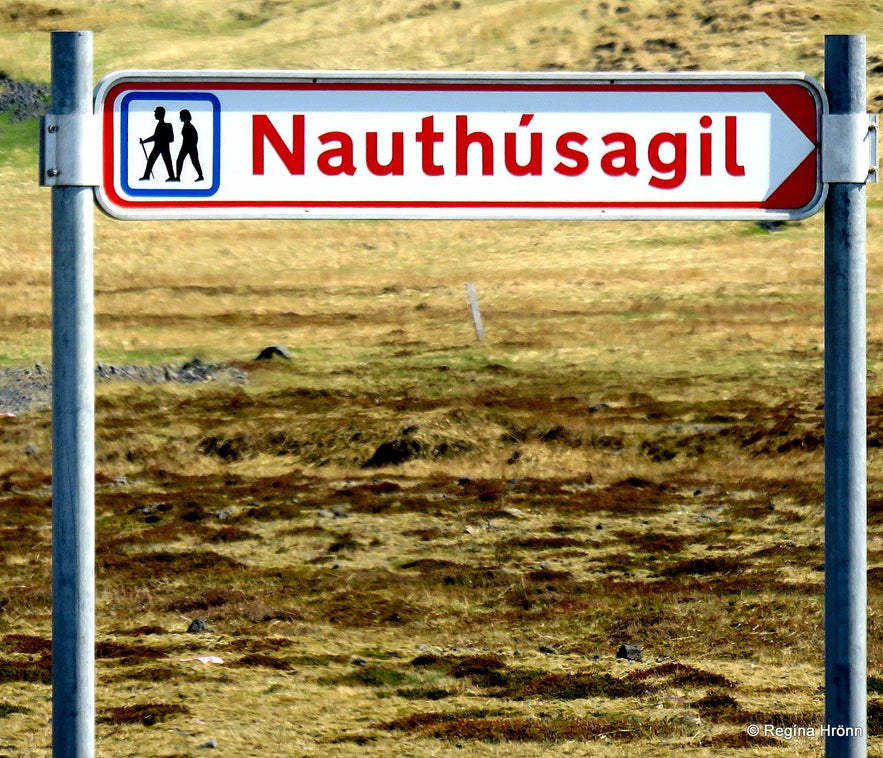
A path has been made above the Nauthúsagil ravine where one can walk and have a look at the ravine from above.
Further on, in the distance, you will find a tall and majestic waterfall which I must hike to on my next visit to this area.
The folklore of the brothers of Nauthús
By Nauthúsagil - Stóra Dímon in the distance
Once upon a time three brothers and their sister lived at the Nauthús farm (abandoned in 1777).
Two of the brothers were ribalds, but the third one was a good man.
To cut a long story short the ribalds ended up murdering their good brother. After the murder of her only good brother the sister fled to Stóridalur valley and got engaged to the farmer there.
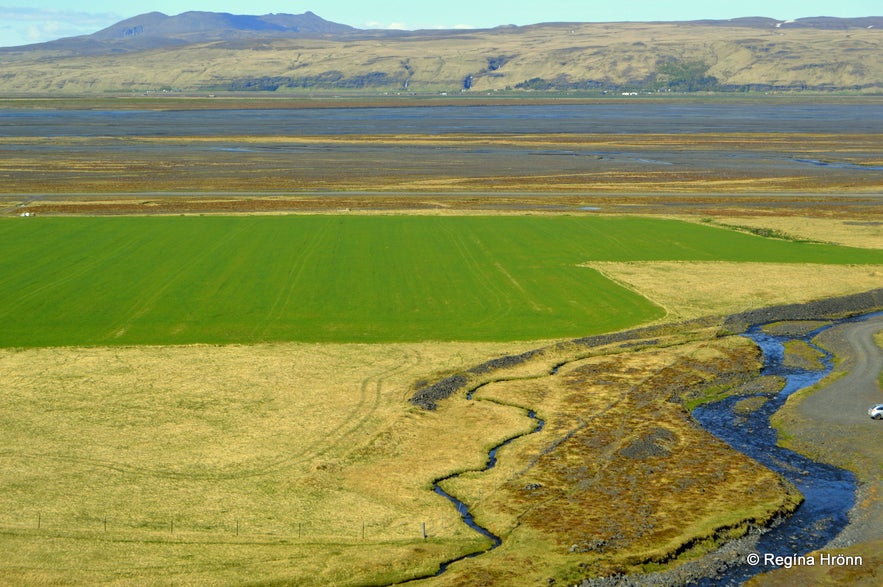
By Nauthúsagil - you can see the gorge with Gluggafoss waterfall in the distance
This match was not to the liking of the ribalds and they swore to kill the farmer at Stóridalur.
Once in the wintertime, as the farmer of Stóridalur was rounding up his sheep and drove the sheep out to Merkurengi meadow there was an ice channel (the deepest part of the river had no ice) in Markarfljót river.
The ribalds lunged at the farmer so he had to retreat into the river. The brothers followed him and drowned. The farmer of Stóridalur was, on the other hand, not harmed.

Nauthúsagil and Nauthúsaá river
There were few people at Nauthús farm for the rest of the winter, but those few who stayed felt the presence of the brothers.
Next spring the sister asked her relative to move to Nauthús farm.
The following summer nothing of importance happened until the nights started getting dark again (but in the summertime in Iceland the nights are bright for the first part of the summer) - then the haunting started!

Nauthúsagil
The farmer at Nauthús asked the farmer at Stóridalur for help and he came to Nauthús farm one evening and stayed for the night.
That night nothing happened but at daybreak, his farmhand came to Nauthús and told him that there had been excessive haunting at Stóridalur that night.
The following night the ghosts again haunted Nauthús. The same thing happened for the rest of the week that the ghosts haunted the farm every night.
The waterfall above the waterfall we visited in Nauthúsagil
The farmer at Stóridalur was the trustee of the Stóridalur church. One night when he was alone in the church one of the ghosts appeared behind him.
The farmer asked the ghost not to kill him yet and told him that a girl in Mörk (Stóramörk) was carrying his child and that child would revenge him.
So the ghost should kill her the following night and him as well. The ghost agreed to this deal and left.
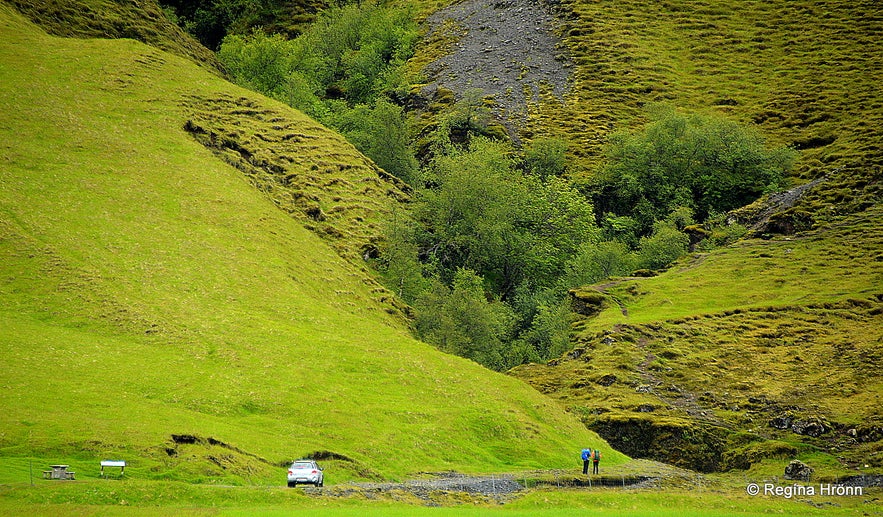
The tree-covered Nauthúsagil
The farmer went to get the girl and told her to stay inside the altar rails for the night.
He then sprinkled holy water all over the church apart from the runner on the floor in the middle of the church.
After dark, the ghost appeared in the church and walked on the runner towards the altar. The farmer followed him and sprinkled holy water on the runner.
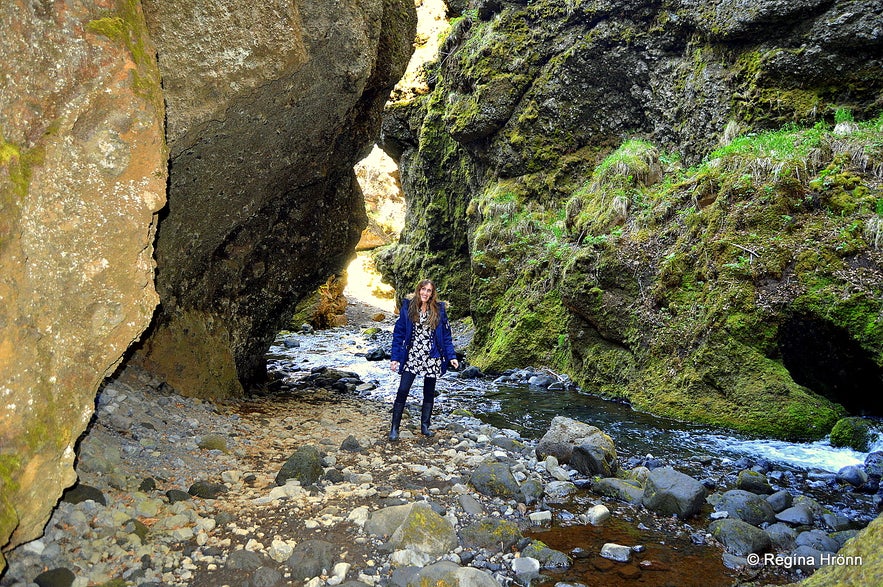
No ghosts here
This cross was on the church floor for the longest time and the ghost was never seen again. The ghosts who are forced into the floor or ground can't reemerge, but in the same spot, they sank.
The other ghost went berserk and played havoc on the farm that night and the following nights so the farmer had to flee his farm.
The Nauthús farm has been abandoned ever since and is still believed to be haunted. I, fortunately, didn't feel any presence of ghosts in the ravine, just happiness for being in such a beautiful place :)
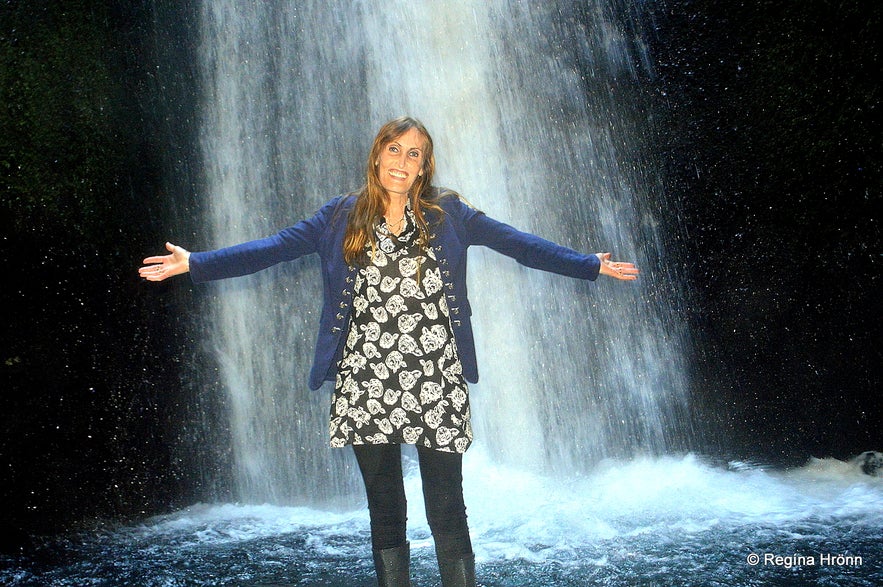
By the beautiful waterfall at the end of our hike in Nauthúsagil
Not far from here you will find the immensely popular waterfall Seljalandsfoss, which is unique as it is so easy to walk behind it. Next to Seljalandsfoss lies Gljúfrabúi waterfall, hidden away behind a big rock in a small gorge.
Gljúfrabúi or the Dweller in the Gorge was not so long ago a hidden location here in these parts of South Iceland but has by now become almost as popular as Seljalandsfoss waterfall.
Above these waterfalls reigns the dreaded Eyjafjallajökull volcano, remember when it erupted back in 2010 and air traffic was severely affected by the ashes which Eyjafjallajökull spouted high in the air?
To reach Nauthúsagil drive east on ring-road 1 for approx. 120, then turn left onto Route 249, pass Seljalandsfoss and Gljúfrabúi waterfalls and drive along that road for a while.
The road becomes a gravel road and changes into F-249, meaning a mountain road, but the rivers to cross are further on in the direction of Þórsmörk. It is quite ok to drive to Nauthúsagil in a 2WD for the first part of the road F-249 in the summertime, but don't go any further.
I often get the question if it is really ok to drive to Nauthúsagil in a 2WD in the summertime, even though this is an F-road - if you are uncertain then you can always check out the roads on Google maps before you go on your trip.
Turn right for Nauthúsagil onto another gravel road and drive the short distance up to a couple of parking places or leave your car by the end of the road and hike to the ravine.
You can also join the guided tour Thorsmork Valley | Super Jeep Day Tour, where Nauthúsagil, the magnificent Stakkholtsgjá canyon, and Þórsmörk valley are visited on a day tour.
I have written a travel-blog about that day tour:
A wonderful Tour to Þórsmörk Valley in South Iceland with Midgard Adventure
Have a lovely time visiting the mystical Nauthúsagil gorge:)
Читать другие блоги
Загадка отеля Radisson 1919
Из истории славного города Рейкьявика Каждый умный человек знает, что свастика, как древний положительный символ движения, благоденствия, солнцеворота, не имеет ничего общего с преступным нацистскимЧитать далееАвтобусы в Рейкьявике и Исландии
Привет, ребята Сейчас очень быстро, без лирических отступлений, расскажу вам об общественном транспорте Рейкьявика - автобусах Stræto. Эти знания вам очень пригодятся, если, приехав в Рейкьявик, выЧитать далееКак Исландия вдохновила легендарных рокеров
Рассказ о том, как песня об Исландии стала классикой рока. Я очень люблю музыку. А музыка - это одна из причин, почему я люблю Исландию. Но история эта не про исландскую группу, а про легенд рок-нЧитать далее

Загрузите приложение крупнейшего туристического портала Исландии на свой телефон, чтобы управлять всей поездкой в одном месте.
Отсканируйте этот QR-код с помощью камеры телефона и нажмите на появившуюся ссылку, чтобы всегда иметь доступ к крупнейшему туристическому порталу Исландии в своем кармане. Введите свой номер телефона или адрес электронной почты, чтобы получить SMS или электронное письмо со ссылкой на скачивание.

